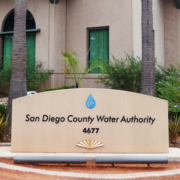With the recession and the COVID-19 pandemic causing economic havoc nationally and across Southern California, the San Diego County Water Authority has adopted several cost-cutting strategies to reduce rate increases and it’s asking the Los Angeles-based Metropolitan Water District of Southern California to do the same.
When the Water Authority’s Board of Directors approved its 2021 rates in June, it limited rate increases to 4.8-4.9% – and more than 60% of that rate increase is directly attributable to MWD. The Water Authority Board also directed staff to return this fall with any other cost savings, specifically, any pass-through savings from MWD.
Water rates and COVID-19
So far, MWD’s Board has directed agency staff to look for cost-cutting measures – but MWD staff is proposing not to offer further rate relief. Even though MWD is proposing to initiate cost-containment efforts to save $11.7 million in FY2021 (less than 0.6% of its budget), MWD’s September rate review memo recommends not to incorporate the savings into its budget and not to offer rate relief because it found member agencies “have not experienced significant [financial] impacts attributable to COVID-19.”
Water agencies face financial pressure
In reality, San Diego County and the nation continue to face a recession and double-digit unemployment, and many water agencies across Southern California are facing financial pressure due to unpaid bills by residents and their own efforts to provide rate relief.
In response to those unprecedented pressures, the Water Authority froze hiring, limited travel and training, and delayed equipment replacement, among other efforts.
“The Water Authority Board believes that it is important for all water suppliers, including MWD, to be recognized as part of the solution for Southern California ratepayers during this difficult time,” said Jim Madaffer, chair of the Water Authority’s Board of Directors. “MWD has an opportunity to help millions of ratepayers by tightening its belt like the Water Authority and numerous other water agencies have already done.”
Nation’s largest water agency has opportunity to help ratepayers across Southern California
Madaffer wrote a letter to MWD’s Board chair this week encouraging the nation’s largest water agency to take additional cost-saving steps. One way MWD could benefit all member agencies would be to reduce its water transportation rates by $15 per acre-foot. This would trim MWD’s budget by about 1.3% and provide $24 million in savings to Southern California water agencies.
However, Madaffer said the Water Authority is open to other ways that MWD can cut costs and reduce rate increases.
“We want to be clear that it also is not our intention to impede in any way MWD’s ability to provide a safe and reliable water supply to its member agencies – to the contrary, we believe these cost savings may be achieved without having any material impact on service,” Madaffer said.
To read Madaffer’s letter and submit a letter of support for rate relief to MWD, go to www.sdcwa.org/support-rate-relief-mwd.




